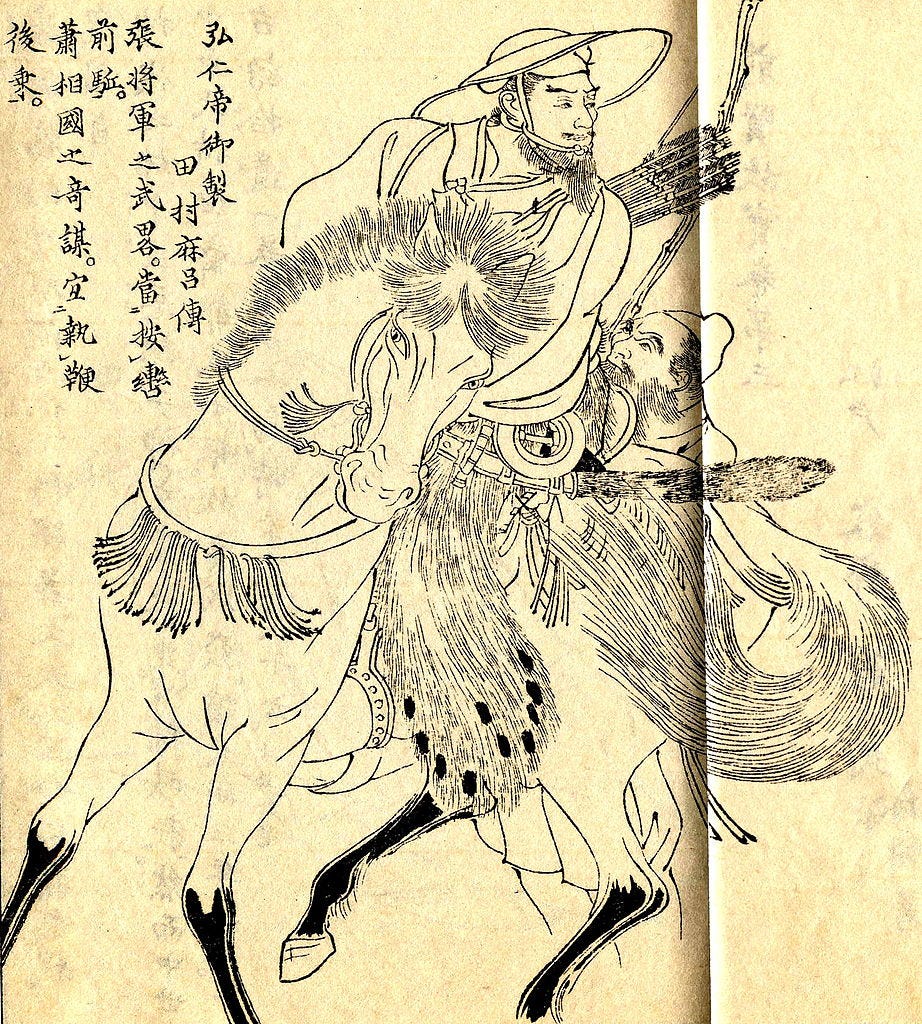Racial identity of Sakanoue no Tamuramaro 坂上田村麻呂の人種的アイデンティティ
Was he black or Chinese?彼は黒人だったのか、それとも中国人だったのか?
The oldest possible record of Sakanoue no Tamuramaro is from June, 785 (4th year of Enryaku "Shoku Nihongi,"). We should therefore bear in mind that this information should take precedence over comments by such people as Alexander Francis Chamberlain who were experts in Anthropology based in the Americas and who were not even able to read or speak ancient Japanese or Chinese, which is necessary for understanding ancient documents. Chamberlain, without evidence, claimed that Sakanoue no Tamuramaro was of “negro” that is to say black decent in 1911. Later this would be repeated by William Edward Burghardt Du Bois in 1915, by Beatrice J. Fleming and Marion J. Pryd in 1946, and Joel Augustus Rogers in 1946. The story was continually recycled from that point. None of the persons mentioned had any background in Chinese Classics or Asian languages.
坂上田村麻呂に関する最古の記録は、延暦4年(785年)6月の『続日本紀』に見られるものです。そのため、この情報は、古代文献を理解するために必要な古代日本語や中国語を読む能力を持たなかった、アメリカ大陸を拠点とする人類学者であるアレクサンダー・フランシス・チェンバレンのような人物によるコメントよりも優先されるべきです。
チェンバレンは1911年に証拠もなく、坂上田村麻呂が「ニグロ」、すなわち黒人の血統であると主張しました。この説は後に、1915年にウィリアム・エドワード・バーグハート・デュボイス、1946年にビアトリス・J・フレミングとマリオン・J・プライド、同年にジョエル・オーガスタス・ロジャースによって繰り返されました。この話はその後も繰り返し引用され続けました。しかし、これらの人物はいずれも中国古典やアジアの言語に関する専門知識を持っていませんでした。
So, what does the "Shoku Nihongi," actually say on the matter? Below is the original text from 785 which requires some detailed understanding of Chinese classics to read and hence I shall translate it.
では、『続日本紀』の785年(延暦4年)の原文が坂上田村麻呂に関して実際に何を述べているのか見てみましょう。以下に当時の原文を挙げます。この文章を正確に理解するには中国古典の深い知識が必要であるため、翻訳を行います。
右衞士督從三位兼下総守坂上大忌寸苅田麻呂等上表言。臣等本是後漢靈帝之曾孫阿智王之後也。漢祚遷魏。阿智王因牛教。出行帶方。忽得寳帶瑞。其像似宮城。爰建國邑。育其人庶。後召父兄告曰。吾聞。東國有聖主。何不歸從乎。若久居此處。恐取覆滅。即携母弟迂興徳。及七姓民。歸化來朝。是則譽田天皇治天下之御世也。於是阿智王奏請曰。臣舊居在於帶方。人民男女皆有才藝。近者寓於百濟高麗之間。心懷猶豫未知去就。伏願天恩遣使追召之。乃勅遣臣八腹氏。分頭發遣。其人民男女。擧落隨使盡來。永爲公民。積年累代。以至于今。今在諸國漢人亦是其後也。臣苅田麻呂等。失先祖之王族。蒙下人之卑姓。望 。改忌寸蒙賜宿祢姓。伏願。天恩矜察。儻垂聖聽。所謂寒灰更煖。枯樹復榮也。臣苅田麻呂等。不勝至望之誠。輙奉表以聞。詔許之。坂上。内藏。平田。大藏。文。調。文部。谷。民。佐太。山口等忌寸十一姓十六人賜姓宿祢。 - 『続日本紀』延暦四年六月条
“The Captain of the Right Guards, a courtier of junior third rank and concurrently the Governor of Shimousa Province, Sakanoue no Ikimi Karitamaro, along with others, submitted a petition, saying:
右衛士督、従三位兼下総守である坂上大忌寸苅田麻呂らが上表し、次のように申し上げました:
"We, your humble subjects, are descendants of Achino-Ou (Prince Achi), the great-grandson of Emperor Ling of the Later Han dynasty. When the Han dynasty fell and was succeeded by Wei, Prince Achi, following divine guidance, departed for Daifang Commandery. There, he unexpectedly discovered a miraculous treasure resembling a palace, which he interpreted as an auspicious sign. He then established a settlement, cultivated the populace, and nurtured the land.
「臣らは、後漢の霊帝の曾孫である阿智王の後裔でございます。漢王朝が滅び、魏がそれに代わると、阿智王は神意に従い、帯方郡に赴きました。そこで彼は、宮殿に似た形をした奇跡的な宝物を偶然発見し、これを吉兆と解釈いたしました。そして、そこに国邑を築き、人々を育て、土地を開拓したのでございます。
Later, he addressed his family and followers, saying: 'I have heard that in the eastern lands, there is a wise and virtuous sovereign. Why should we not submit to and serve him? If we remain here too long, I fear that calamity will befall us.' With this in mind, he took his younger brother Ukokutoku (Ukjotoku) and seven clans of his people, submitting and coming to the imperial court. This took place during the reign of Emperor Ojin (誉田天皇).
その後、阿智王は家族や従者たちに向かってこう語りました。「東の地には、賢く徳高い君主がおられると聞く。我々はなぜその方に帰順し仕えないのか。この地に長く留まれば、災いが降りかかるのではないかと恐れる。」そう考えた阿智王は、弟の迂興徳(うこくとく)や七姓の民を伴い、朝廷に帰順して参上しました。これは誉田天皇(応神天皇)の御代に起こったことでございます。
At that time, Prince Achi petitioned the emperor, saying: 'My former residence was in Daifang, where the men and women are all highly skilled. Recently, they have been residing in the regions of Baekje and Goguryeo, but their hearts are uncertain, not knowing whether to stay or leave. I humbly beseech your gracious imperial favor to send an envoy to summon them.'
その時、阿智王は天皇に奏上して申し上げました。「臣の旧居である帯方郡には、男女を問わず皆が高度な技芸を持つ者たちが住んでおりました。近年、彼らは百済や高句麗の地に身を寄せておりますが、心中に迷いがあり、去るべきか留まるべきか決めかねております。どうか天恩を賜り、使者をお遣わしいただき、彼らを召し寄せていただけますよう、伏してお願い申し上げます。」
The emperor issued an edict, dispatching Yatsuhashi no Miyatsuko, who went to those regions and conveyed the imperial order. Consequently, the people, men and women alike, all followed the envoy and came to Japan, becoming permanent imperial subjects. This practice has continued for generations and remains so to this day. The Han people (Kara-jin) now residing in various provinces are also their descendants.
天皇は勅命を発し、**八腹宿禰(やつはらのすくね)**を派遣されました。八腹宿禰はこれらの地域に赴き、勅命を伝えました。その結果、男女を問わず全ての人々が使者に従い、日本へ移住し、永く公民となりました。この慣習は代々受け継がれ、現在に至るまで続いております。現在、諸国に居住している漢人(からじん)もまた、彼らの末裔でございます。
However, we, Karitamaro and others, have lost the royal status of our ancestors and have been burdened with lowly surnames. We humbly request that our current surname, Ikimi (忌寸), be changed, and that we be granted the surname Sukuné (宿祢). We earnestly beseech your heavenly grace to consider this matter. Should you grant us this favor, it would be like reviving cold ashes to warmth or restoring a withered tree to bloom. With utmost sincerity, we present this petition to the court."
しかしながら、臣ら苅田麻呂等は、先祖が持っていた王族としての地位を失い、卑しい姓である忌寸(いみき)を名乗ることとなりました。どうか、この忌寸の姓を改め、宿祢(すくね)の姓を賜りますよう伏してお願い申し上げます。この恩恵を賜れば、寒灰が再び温かくなり、枯れた木が再び栄えるようなものでございます。臣らはこの願いを誠心誠意申し上げます。ここに上表を捧げ、朝廷にお聞き届けいただきたく存じます。」
The emperor granted their request. Sakanoue, Uchikura, Hirata, Okura, Fumi, Tsukuri, Fumibe, Tani, Min, Sata, and Yamaguchi, a total of 16 individuals from 11 clans, were granted the surname Sukuné (宿祢). (From the "Shoku Nihongi," Entry for Enryaku 4, 6th Month)”
天皇はその願いを許しました。坂上氏、内蔵氏、平田氏、大蔵氏、文氏、調氏、文部氏、谷氏、民氏、佐太氏、山口氏の11氏族、合計16人に対し、宿祢(すくね)の姓が賜られました。(『続日本紀』延暦4年6月条より)
So here we see that the Emperor graciously awarded them surnames, but why did he do that? Was it in recognition of African decent? No, rather, the Emperor recognised that they were Han Chinese descendants of the Later Han Dynasty that had fled to Baekje and Goguryeo (two ancient Korean Kingdoms) and that had come to Japan after the Emperor of that time sent his envoy Yatsuhashi no Miyatsuko to bring them to Japan. So, the royal records would have been checked to show that this information was accurate. After this they were given their family names in the Japanese style and allowed to fully integrate. There is no mention of Africa, which did not even exist in the Japanese mind at the time. Therefore, Sakanoue no Tamuramaro was a Japanese man whose ancestors are verifiable included Han Chinese and possibly Baekje and Goguryeo (if intermarriages occured although that is not mentioned by the text). Sakanoue no Tamuramaro was therefore 100% Asian and no 20th Century ramblings will change that.
ここで分かるのは、天皇が彼らに姓を授けたことは、アフリカ系の出自を認めたからではないという点です。むしろ、天皇は彼らが後漢の漢人の末裔であり、百済や高句麗(いずれも古代朝鮮の王国)に逃れた後、当時の天皇が派遣した使者である**八腹宿禰(やつはらのすくね)**によって日本に招かれたことを認識したのです。この情報の正確性を確認するため、皇室の記録が確認されたと考えられます。その後、彼らは日本式の姓を与えられ、完全に統合されることを許されたのです。
記録にはアフリカについての言及は一切ありません。当時の日本人の意識において、アフリカという概念そのものが存在していなかった可能性が高いのです。したがって、坂上田村麻呂は日本人であり、その先祖には確認可能な漢人が含まれており、さらに可能性としては百済や高句麗との通婚があったかもしれませんが、記録にはそれについての記述はありません。
結論として、坂上田村麻呂は完全にアジア系であり、20世紀以降の憶測がこれを覆すことはできません。


